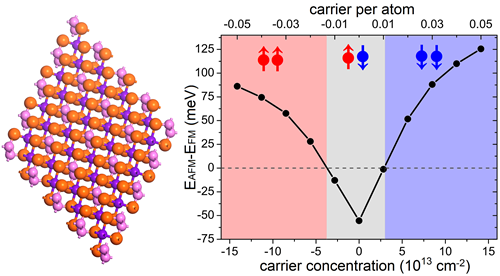The research group of Prof.YANG Jinlong from Hefei National Laboratory for Physical Sciences at Microscale has made new progress in electrical manipulation of carrier’s spin orientation in semiconductors, which makes it possible to fabricate electric-field controlled spintronic devices. The paper has been published in J. Am. Chem. Soc online [DOI: 10.1021/ja505097m].
Spintronics, which exploits the spin of electrons for information processing, possesses great potential advantages compared with the conventional charge-based electronic devices. In developing a spintronic device, generating and manipulating the spin-polarized carriers with electric field is highly desirable, but facing many challenges. Previously, a conceptual material of bipolar magnetic semiconductor with designed electronic structure has been proposed for this purpose by the same group [Nanoscale 4, 5680 (2012)]. In bipolar magnetic semiconductors, completely spin-polarized currents with tunable spin-polarization can be provided simply by applying a gate voltage. However, searching bipolar magnetic semiconductors that are feasible in experiment is a challenging job.

Based on experimentally synthesized three dimensional (3D) layered crystal MnPSe3, the group of Prof. Jinlong Yang propose to obtain 2D MnPSe3 nanosheet by liquid exfoliation of its bulk structure in experiment. Such a nanosheet functions as a good bipolar magnetic semiconductor. At its ground state, 2D MnPSe3 nanosheet is an antiferromagnetic semiconductor, whereas both electron and hole doping induce its transition from antiferromagnetic semiconductor to ferromagnetic half metal, exhibiting complete spin-polarization around the Fermi level. Moreover, the spin-polarization directions of 2D half-metallic MnPSe3 are opposite for electron and hole doping, which can be controlled by applying an external voltage gate. The Monte Carlo simulation based on the Ising model suggests the Curie temperature of the doped 2D MnPSe3 is up to 206 K. These advantages render the 2D MnPSe3 crystal great potentials for application in electric-field controlled spintronic devices.
The above research was supported by Chinese Academy of Sciences, Ministry of Science and Technology, National Natural Science Foundation and Ministry of Education.